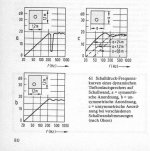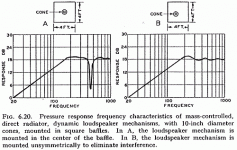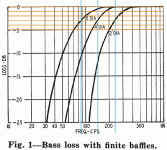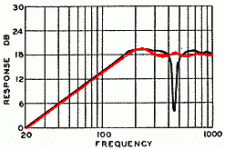Here's another chart. I'll try to attach it
The question is: is this baffle sitting on the floor? If not it seems to imply that moving the driver to one side DOESN"T affect the cut off frequency. You German speakers can help here!!! It does seem to mention the holy name of Olson
The question is: is this baffle sitting on the floor? If not it seems to imply that moving the driver to one side DOESN"T affect the cut off frequency. You German speakers can help here!!! It does seem to mention the holy name of Olson
Attachments
Variac said:Damn! I've been using that same chart that Jaq posted! It's a real classic. Dave, could you check your calcs again?
I have that chart of my HD too. Something about it didn't look quite right so i dug out Olson. On page 149: "The transition between doublet operation and independent operation is quite marked. The transition point occurs when the dimension of the baffle are slightly less than one-half wavelength"
The chart is simply frequency vrs a half wavelength. If you look back to Olson's graph of the centred & non-centred baffle, the cutoff cooresponds pretty close to my chart.
Attached is an annotated graph from Hartley (Radio-Electronics Aug 54). The 4' & 8' traces correspond fairly close to my chart. I guess i'll have to make a chart with a bit more scope.
dave
Attachments
Variac said:It does seem to mention the holy name of Olson
Yes, those are "paraphrased" from Olson's book.
The actual FR is actually quite complex. Olson has a whole series of charts showing the effects of various parameters including such things as the resonance of the speaker.
I'll see if i can dig up the preprint from the AES 107 by Juha Backman (IIRC) where he does a 1st attempt at calculating the frequency response of a speaker placed on an arbitrary baffle. Basically it involves the distance radially from the driver to the baffle edge and a whole bunch of calculations.
dave
Re: Rotated with XnView
Another wheeze you might like to try is covering the tweeter front plate with thin felt (cut a hole for the dome and copper bit). Together with rounded edges and felt covered baffles, it cleans up the off-axis response beautifully.
halojoy said:I see you use SEAS Excel elements
JAMO Concert 8 and 11 uses them, too. GREAT reviews!
Jamo Concert 11 is the Big Floorstanding model.
"JAMO Consert 8 was appointed European Speaker of the Year, and received the prestigious EISA Award in 1997."
Here is the new version, called:
Jamo D 830
Here is about Jamo Concert 11 and Consert 8 - at TNT-Audio
http://www.tnt-audio.com/casse/jamo8e.html
--------------------
in this case I should have Rotated before save
to save some of the space in this Thread
like this
Another wheeze you might like to try is covering the tweeter front plate with thin felt (cut a hole for the dome and copper bit). Together with rounded edges and felt covered baffles, it cleans up the off-axis response beautifully.
The crossover is just a 100k resistor and a 15nF cap for the woofer (100Hz at 6dB/octave) and the FR has a voltage devider to compensate for the losses in the woofer xover (47.5k and 47.5k). The baffle width and natural rolloff cause the tangband to fall off right where the woofer does, the FR will roll off at higher than a first order, but without the nasties (well, all the nasties) of a higher order electrical crossover. The woofers response in an openbaffle of the width I posted should have a dip around 120Hz-150Hz, so combining my 6dB xover there should result in a higher order slope (again, without the hassle of the higher order xovers, especially passive line-level xovers). The end result is rather pleasing (I listen to them all the time). At the moment I'm finishing them off (making them perdy) and properly mounting the xover in a box. When it's all done I'll show everything on them, but the crappy pictures I posted earlier don't give them justice and I'd rather show them completed...
JoeBob said:The crossover is just a 100k resistor and a 15nF cap for the woofer (100Hz at 6dB/octave) and the FR has a voltage devider to compensate for the losses in the woofer xover (47.5k and 47.5k).
This is a PLLXO is it not?
dave
Indeed it is dave. I wasn't going to spend more on the xover than the rest of the speaker. But the PLLXO does work amazingly well, since it doesn't have an electrical xover on the fullrange driver it doesn't depend on the impedence of the amp it's driving, which makes it comvinient so that I don't have to redesign the xover for every amp it's used with (such is the problem with PLLXOs as you know).
OK Dave , doesn't it appear to you that the baffle diagrams that show the suck out problems also show that the roll off point doesn't change as you move the driver closer to an edge? This says to me that you don't use the shortest dimension from your chart to determine the rolloff, but rather some sort of average. I believe that the charts show that all the sound doesn't "short circuit" around the short baffle dimension- only the sound that was heading that way anyway!
Another point that has been discussed a bit by Joe Bob: A rectangular baffle sitting on the floor with the drivers different distances from the edges and top can have the drivers in the centerline vertically and still not have the drivers in the center in the manner that causes the big suckouts. That is only caused by the driver being equal distance from all edges.
I would think the distance to the floor is actually infinate-in effect one dimension is an infinate baffle. I'm pretty sure those charts are showing a baffle in the air-not sitting on the floor.
JOeBOb- how did you calculate your baffle? and does it respond according to your calculations?
Another point that has been discussed a bit by Joe Bob: A rectangular baffle sitting on the floor with the drivers different distances from the edges and top can have the drivers in the centerline vertically and still not have the drivers in the center in the manner that causes the big suckouts. That is only caused by the driver being equal distance from all edges.
I would think the distance to the floor is actually infinate-in effect one dimension is an infinate baffle. I'm pretty sure those charts are showing a baffle in the air-not sitting on the floor.
JOeBOb- how did you calculate your baffle? and does it respond according to your calculations?
Dave, the amps I'm using to power the highs and lows are both Power Follower 99Cs (well, a variation thereof) with tube voltage gain stages.
Variac, I used the excel sheet I posted earlier, as well as looking at many graphs on the net, the one jag posted included (it was the first I fell upon and I folowed it at first). As for if my results are acurate with my calculations, yes and no. The fullrange driver drops off as predicted, but it also naturally rolls off around a hundred and someodd hertz, as well it's FS is 110Hz so it should drop at 12dB/octave below that (as is with open baffles I do believe, could be wrong though), so the baffle width might not be the determining factor. With the bass, it seems to go as low as Thorsens spreadsheet shows, but the spreadsheet graphed a response lower than the graphs posted here would sudjest.
One thing to edit, I don't see how the graphs Dave posted could be right, if so I wouldn't hear anything under a hundred and someodd hertz, which I do indeed hear it. Maybe it represents a different distance and we're not interpreting them correctly, but I have no explanation for them.
Variac, I used the excel sheet I posted earlier, as well as looking at many graphs on the net, the one jag posted included (it was the first I fell upon and I folowed it at first). As for if my results are acurate with my calculations, yes and no. The fullrange driver drops off as predicted, but it also naturally rolls off around a hundred and someodd hertz, as well it's FS is 110Hz so it should drop at 12dB/octave below that (as is with open baffles I do believe, could be wrong though), so the baffle width might not be the determining factor. With the bass, it seems to go as low as Thorsens spreadsheet shows, but the spreadsheet graphed a response lower than the graphs posted here would sudjest.
One thing to edit, I don't see how the graphs Dave posted could be right, if so I wouldn't hear anything under a hundred and someodd hertz, which I do indeed hear it. Maybe it represents a different distance and we're not interpreting them correctly, but I have no explanation for them.
Variac said:OK Dave , doesn't it appear to you that the baffle diagrams that show the suck out problems also show that the roll off point doesn't change as you move the driver closer to an edge? This says to me that you don't use the shortest dimension from your chart to determine the rolloff, but rather some sort of average. I believe that the charts show that all the sound doesn't "short circuit" around the short baffle dimension- only the sound that was heading that way anyway!
The problem of when things roll-off is more complex than a "2-dimensional" one. The chart is probably only accurate (and by Olson will be a but pessimistic), in the case of a circular baffle with the driver in the middle.
In the suck-out charts the cut-off does move slightly up as can be seen when you superimpose the 2 traces.
dave
Attachments
JoeBob said:Power Follower 99Cs
Is there a thread (or web site) that describes these... i have heard mention of them before, but haven't Groked them yet.
dave
planet10 said:Is there a thread (or web site) that describes these... i have heard mention of them before, but haven't Groked them yet.
dave
Andrea C. has some Power Followers
and uses TUBES
Single Ended Pure Class A Power Follower Amplifier (Andrea Ciuffoli)
probably is another JoeBob have in mind.
/halo - not always a "Dedicated Follower Of Fashion"
YA TB OB
My first DIY speaker is a TB OB, effective baffle size: 4'X3'. Still playing (and having fun) with the crossover - will post details once finalized. Disadvantages: Huge; low SPL (limited by TB - definitely not suitable for HT); placement (requires large breathing space); very big!; large crossover components; very very big!!. Advantages: Dipole sound (cheap way to find out what the fuss is all about - placement problems!); imaging; deep bass (that 12 incher - high Xmax, and high Vas - is designed to provide a big boom in a box, shines in OB high-ish Q and low Xmax: linear response) - limited SPL; simple (construction & crossover: a bad crossover at 100-200Hz is a lot better than a bad crossover at 200-20,000Hz). Its looks match well with my Zen4.
The protrusions on the front baffle provide an integrated frame for grill cloth (can always be trimmed - trimming bit - if required).
My first DIY speaker is a TB OB, effective baffle size: 4'X3'. Still playing (and having fun) with the crossover - will post details once finalized. Disadvantages: Huge; low SPL (limited by TB - definitely not suitable for HT); placement (requires large breathing space); very big!; large crossover components; very very big!!. Advantages: Dipole sound (cheap way to find out what the fuss is all about - placement problems!); imaging; deep bass (that 12 incher - high Xmax, and high Vas - is designed to provide a big boom in a box, shines in OB high-ish Q and low Xmax: linear response) - limited SPL; simple (construction & crossover: a bad crossover at 100-200Hz is a lot better than a bad crossover at 200-20,000Hz). Its looks match well with my Zen4.
The protrusions on the front baffle provide an integrated frame for grill cloth (can always be trimmed - trimming bit - if required).
Attachments
Re: Nice work, jag
Should read as:
deep bass (that 12 incher - high Q, and high Vas - is designed to provide a big boom in a box, shines in OB high-ish Q and low Xmax: linear response) - limited SPL
It is all wood, damping is another parameter I am currently playing with. It is amazing that something as benign as a first-order crossover at 200 and damping can affect sound so much! I am not sure about better or worse but it does sound different with different crossover values and damping. That is another advantage of OB - everything is easily accessible to be tweaked.
jag said:deep bass (that 12 incher - high Xmax, and high Vas - is designed to provide a big boom in a box, shines in OB high-ish Q and low Xmax: linear response) - limited SPL
Should read as:
deep bass (that 12 incher - high Q, and high Vas - is designed to provide a big boom in a box, shines in OB high-ish Q and low Xmax: linear response) - limited SPL
halojoy said:Is it all wood, or have you used
some other boards as well?
I guess you have some damping stuff inside.
/halo
It is all wood, damping is another parameter I am currently playing with. It is amazing that something as benign as a first-order crossover at 200 and damping can affect sound so much! I am not sure about better or worse but it does sound different with different crossover values and damping. That is another advantage of OB - everything is easily accessible to be tweaked.
- Status
- This old topic is closed. If you want to reopen this topic, contact a moderator using the "Report Post" button.
- Home
- Loudspeakers
- Multi-Way
- Uber cheap, yet amazingly good.




